By James Heinz
On December 1, 1937, legendary Milwaukee born underwater adventurer Max Nohl made a record setting test dive in Lake Michigan from the deck of the Coast Guard cutter ANTIETAM to a depth of 420 feet off Port Washington, Wis., using an experimental mixed gas diving rig. The dive was broadcast live on national radio.
On April 10, 1937, Max made a preliminary test dive of his equipment. The equipment was revolutionary in that it was not connected to the surface by an air hose, like almost all diving equipment of the time.
The equipment also substituted the nitrogen found in normal air with helium, which avoided the dreaded nitrogen narcosis that occurred with breathing normal air at depth. Helium is also lighter than nitrogen, which reduced the effort required to breathe at depth and lessened the number of decompression stops required before surfacing. Helium, however, has the disadvantages of conducting heat six times faster than air, which increased the danger of hypothermia. Helium has one other major disadvantage:
It makes the diver sound like Donald Duck when speaking.
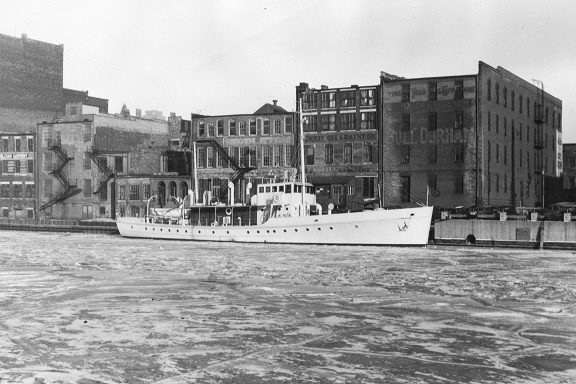
CG Cutter ANTIETAM at Milwaukee, 1938
WMHS files include an account of the April 10th dive from none other than the late Courtland Conlee, past president of WMHS. In an article written for our newsletter SOUNDINGS (Volume 16, #2), he gave his eyewitness account of the dive. Conlee was present in his role as the Promotion Manager for the Milwaukee Journal newspaper. Conlee’s article states that the dive was planned more as a promotional “first” for WTMJ radio, which was owned by the Journal. Reporter Russ Winnie of WTMJ was on board to broadcast the dive.
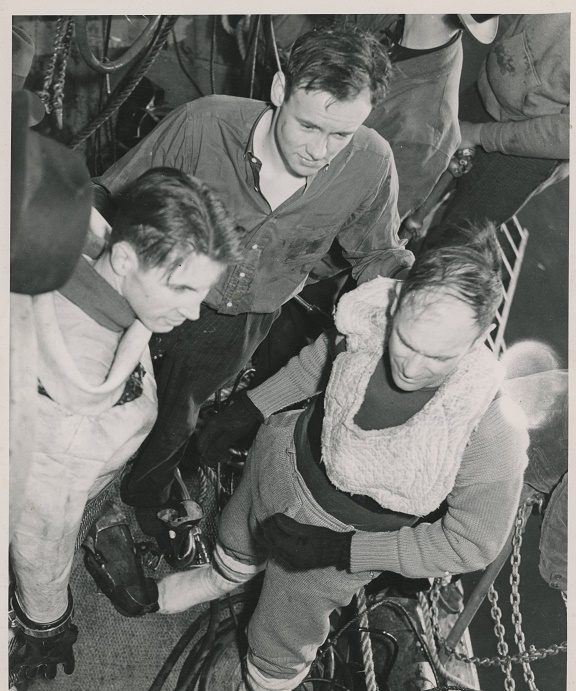
Dressing for the dive test – Max Nohl, Jack Browne, John Craig
The ANTIETAM anchored in 58 feet of water off Milwaukee. Max Nohl went first, lowered over the side by a hook attached to his helmet. He was accompanied by someone Conlee described as “commercial diver John D. Craig”, who went over the side in conventional hard hat diving gear by climbing down a ladder. Russ Winnie broadcast the “play by play” live over the radio, and the divers’ telephone conversations with the surface were also broadcast live over WTMJ.
The divers touched down on a rock and clay bottom. Their telephone transmissions were being transmitted and everything was going fine.
Until it wasn’t.
According to Conlee, both divers encountered the pilot house of an unknown sunken ship. Nohl’s telephone line and Craig’s telephone line and air hose became entangled with each other and with the wreckage. It was dark and the silt the divers kicked up made the visibility even worse. It was hard for them to see and untangle themselves. Knowing they were being broadcast live, the divers tried to remain calm, although according to Conlee, Winnie apparently got excited even though he was not in any danger.
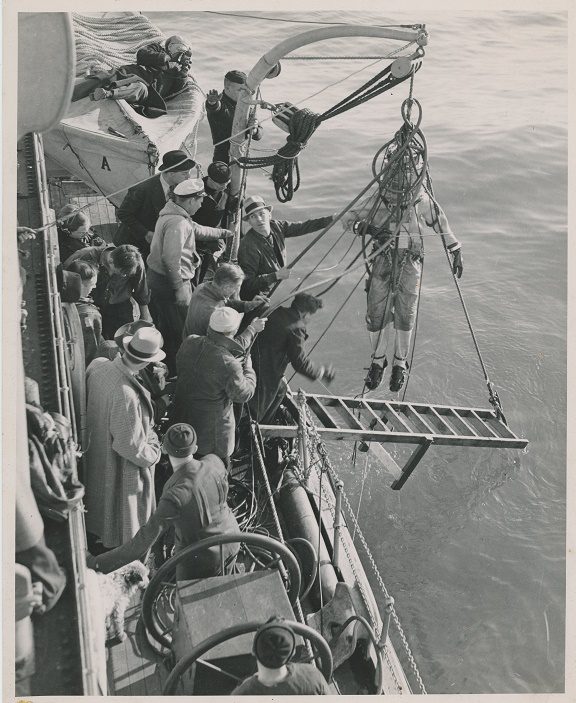
Max Nohl being hoisted out of the water wrapped in a tangle of lines
After the divers made numerous urgent suggestions for untangling them to the ANTIETAM’s crew, the problem was resolved by the ANTIETAM pulling up the entire confused mess of divers, lines and hoses, and the pilot house of the unknown sunken ship that they were all entangled in. An accompanying photo shows Max being hoisted out of the water, his helmet wrapped in a tangle of lines.
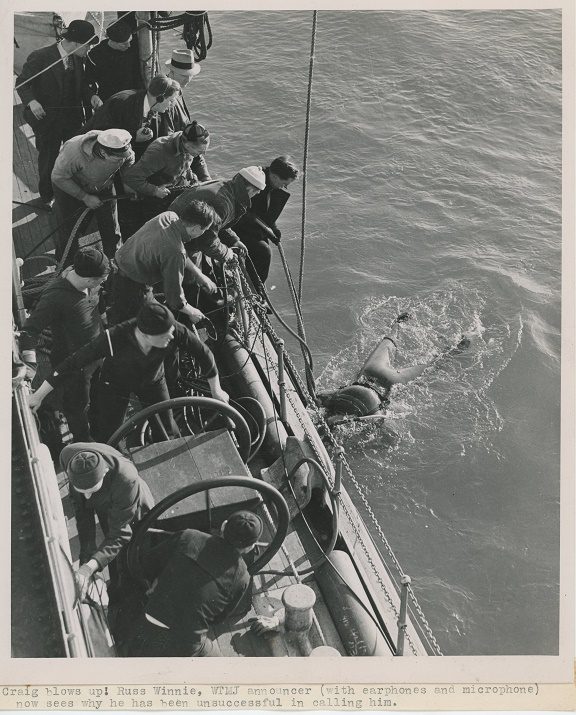
John Craig as a human trapped inside of a balloon
Craig apparently suffered a “blow up” in which his suit inflated so that he became a human trapped inside a balloon, unable to control his movements. Another accompanying photo shows him being reeled in by the crew of the ANTIETAM after he popped to the surface. The man with the headphones in the upper left is reporter Winnie, and the man standing by him in a bowler hat is Conlee himself. He appears to be smoking a cigar. The box with a large wheel mounted on each side is the hand operated air pump supplying Craig and you can see two ANTIETAM crewmen turning the wheels.
Although Conlee’s article describes the dive as being off the Milwaukee suburb of Fox Point, captions attached to the accompanying photos from Milwaukee Public Library files indicate that the dive took place on the wreck of the steamer NORLAND, which sank in 1922 south of Milwaukee and lies in 58 feet of water, the exact depth Conlee reported. Although the test dive failed the test, it would set the stage for the December 1st dive.
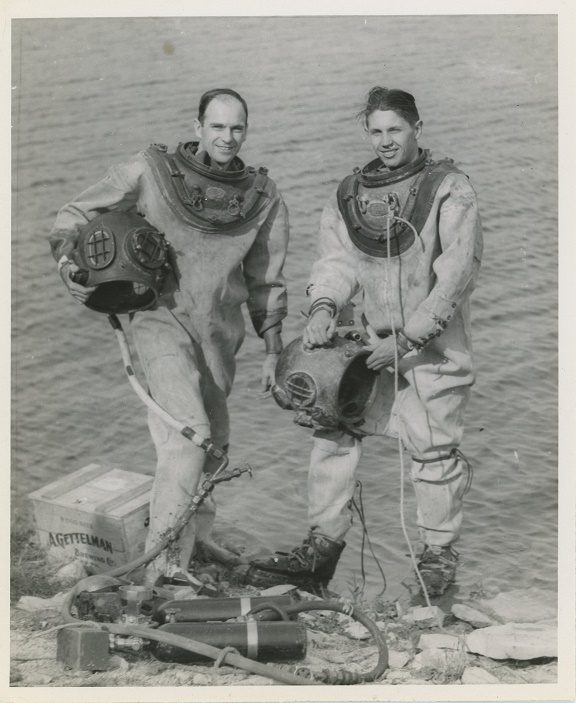
John Craig on left and Max Nohl on right
The story does not end there. John D. Craig was not just a commercial diver. According to his Wikipedia page; “John D. Craig (1903–1997) was an American businessman, writer, soldier, diver, Hollywood stunt man, film producer, and television host.” In 1937 he, Nohl, and others, would establish the Divers Equipment and Salvage Company (DESCO) which still manufactures classic hard hat diving equipment in New Berlin, Wis., https://www.divedesco.com/
DESCO also sponsors the Lake Michigan Classic Diving Organization (LMCDO) which still conducts diving exhibitions in the classic hard hat gear. https://www.facebook.com/lakemichiganclassicdiving/
John D. Craig would publish his autobiography Danger Is My Business, in 1938. The manuscript of Max Nohl’s autobiography, I Live Underwater was donated to the Milwaukee Public Library by the Nohl family many years ago. MPL turned it over to WHS and after 10 years of part time editing by Wisconsin state underwater archeologist Tamara Thomsen, it will be released in May 2025.
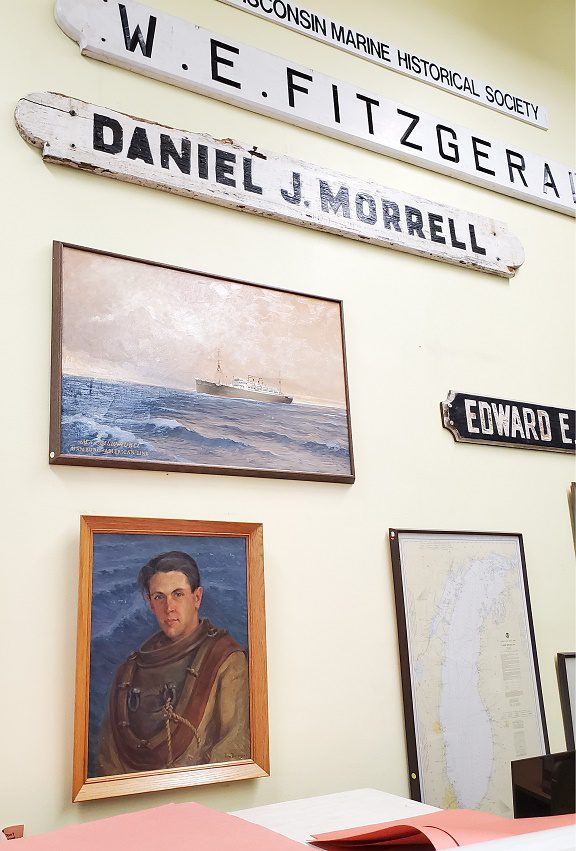
Painting of Max Nohl by Joan Beringer hangs in the Humanities Department of Milwaukee’s Central Library
Photo credit: Great Lakes Marine Collection of the Milwaukee Public Library and Wisconsin Marine Historical Society
——————————–
James Heinz is the Wisconsin Marine Historical Society’s acquisitions director. He became interested in maritime history as a kid watching Jacques Cousteau’s adventures on TV. He was a Great Lakes wreck diver until three episodes of the bends forced him to retire from diving. He was a University of Wisconsin – Milwaukee police officer for thirty years. He regularly flies either a Cessna 152 or 172.

